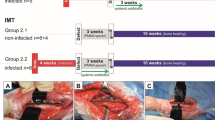Abstract
Purpose
This study aimed to provide preliminary evidence regarding effectiveness of grafting beta-tricalcium phosphate (β-TCP) combined with a cancellous autograft for treating nonunion of long bones in the lower extremity due to infection by evaluating clinical and radiological outcomes.
Methods
We retrospectively reviewed the clinical and radiological results in seven patients (six men, one woman; median age 39 years) treated by the induced membrane technique for nonunion of the femur or tibia due to infection. In the second stage of the procedure, the bony defect was filled with a combination of autologous cancellous bone and β-TCP, which were mixed in approximately the same proportions. The time interval between the second stage of the procedure and bone healing was investigated. Radiographic characteristics including maximum bone gap and radiographic apparent bone gap were evaluated.
Results
The median follow-up period was 14 months. Bone healing was achieved in a median of six months after the second procedure. The median maximum bone gap and radiographic apparent bone gap were 55 mm and 34 mm, respectively.
Discussion
Use of β-TCP, which has osteoconductive ability, with an autograft provided good clinical and radiological outcomes. The findings of this preliminary study suggest the potential of β-TCP as a useful bone substitute for autografts in the induced membrane technique.
Conclusions
Our findings suggest that β-TCP may be an effective extender when using the induced membrane technique.




Similar content being viewed by others
References
El-Gammal TA, Shiha AE, El-Deen MA, El-Sayed A, Kotb MM, Addosooki AI, Ragheb YF, Saleh WR (2008) Management of traumatic tibial defects using free vascularized fibula or Ilizarov bone transport: a comparative study. Microsurgery 28(5):339–346
Yokoyama K, Itoman M, Nakamura K, Tsukamoto T, Saita Y, Aoki S (2001) Free vascularized fibular graft vs. Ilizarov method for post-traumatic tibial bone defect. J Reconstr Microsurg 17(1):17–25
Masquelet AC, Fitoussi F, Begue T, Muller GP (2000) Reconstruction of the long bones by the induced membrane and spongy autograft. Ann Chir Plast Esthet 45(3):346–353
Masquelet AC (2003) Muscle reconstruction in reconstructive surgery: soft tissue repair and long bone reconstruction. Langenbeck’s Arch Surg 388(5):344–346
Ronga M, Ferraro S, Fagetti A, Cherubino M, Valdatta L, Cherubino P (2014) Masquelet technique for the treatment of a severe acute tibial bone loss. Injury 45(Suppl 6):S111–S115
Micev AJ, Kalainov DM, Soneru AP (2015) Masquelet technique for treatment of segmental bone loss in the upper extremity. J Hand Surg Am 40(3):593–598
Olesen UK, Eckardt H, Bosemark P, Paulsen AW, Dahl B, Hede A (2015) The Masquelet technique of inducerd membrane for healing of bone defects. A review of 8 cases. Injury 46(Suppl 8):S44–S47
Scholz AO, Gehrmann S, Glombitza M, Kaufmann RA, Bostelmann R, Flohe S, Windolf J (2015) Reconstruction of septic diaphyseal bone defects with the induced membrane technique. Injury 46(Suppl 4):S121–S124
Porter RM, Liu F, Pilapil C, Betz OB, Vrahas MS, Harris MB, Evans CH (2009) Osteogenic potential of reamer irrigator aspirator (RIA) aspirate collected from patients undergoing hip arthroplasty. J Orthop Res 27(1):42–49
McCall TA, Brokaw DS, Jelen BA, Scheid DK, Scharfenberger AV, Maar DC, Green JM, Shipps MR, Stone MB, Musapatika D, Weber TG (2010) Treatment of large segmental bone defects with reamer-irrigator-aspirator bone graft: technique and case series. Orthop Clin North Am 41(1):63–73
Stafford PR, Norris BL (2010) Reamer-irrigator-aspirator bone graft and bi Masquelet technique for segmental bone defect nonunions: a review of 25 cases. Injury 41(Suppl 2):S72–S77
Dawson J, Kiner D, Gardner W 2nd, Swafford R, Nowotarski PJ (2014) The reamer-irrigator-aspirator as a device for harvesting bone graft compared with iliac crest bone graft: union rates and complications. J Orthop Trauma 28(10):584–590
Taylor BC, French BG, Fowler TT, Russell J, Poka A (2012) Induced membrane technique for reconstruction to manage bone loss. J Am Acad Orthop Surg 20(3):142–150
Haines NM, Lack WD, Seymour RB, Bosse MJ (2016) Defining the lower limit of a "critical bone defect" in open Diaphyseal Tibial fractures. J Orthop Trauma 30(5):e158–e163
Masquelet AC, Begue T (2010) The concept of induced membrane for reconstruction of long bone defects. Orthop Clin North Am 41(1):27–37
Jiang SD, Jiang LS, Dai LY (2008) Surgical treatment of calcaneal fractures with use of beta-tricalcium phosphate ceramic grafting. Foot Ankle Int 29(10):1015–1019
Dai LY, Jiang LS (2008) Single-level instrumented posterolateral fusion of lumbar spine with beta-tricalcium phosphate versus autograft: a prospective, randomized study with 3-year follow-up. Spine (Phila Pa 1976) 33(12):1299–1304
Larsson S (2010) Calcium phosphates: what is the evidence? J Orthop Trauma 24(Suppl 1):S41–S45
Shen C, Ma J, Chen XD, Dai LY (2009) The use of beta-TCP in the surgical treatment of tibial plateau fractures. Knee Surg Sports Traumatol Arthrosc 17(12):1406–1411
Taylor BC, Hancock J, Zitzke R, Castaneda J (2015) Treatment of bone loss with the induced membrane technique: techniques and outcomes. J Orthop Trauma 29(12):554–557
Wang X, Luo F, Huang K, Xie Z (2016) Induced membrane technique for the treatment of bone defects due to post-traumatic osteomyelitis. Bone Joint Res 5(3):101–105
Mauffrey C, Giannoudis PV, Conway JD, Hsu JR, Masquelet AC (2016) Masquelet technique for the treatment of segmental bone loss have we made any progress? Injury 47(10):2051–2052
Apard T, Bigorre N, Cronier P, Duteille F, Bizot P, Massin P (2010) Two-stage reconstruction of post-traumatic segmental tibia bone loss with nailing. Orthop Traumatol Surg Res 96(5):549–553
Author information
Authors and Affiliations
Corresponding author
Rights and permissions
About this article
Cite this article
Sasaki, G., Watanabe, Y., Miyamoto, W. et al. Induced membrane technique using beta-tricalcium phosphate for reconstruction of femoral and tibial segmental bone loss due to infection: technical tips and preliminary clinical results. International Orthopaedics (SICOT) 42, 17–24 (2018). https://doi.org/10.1007/s00264-017-3503-5
Received:
Accepted:
Published:
Issue Date:
DOI: https://doi.org/10.1007/s00264-017-3503-5




